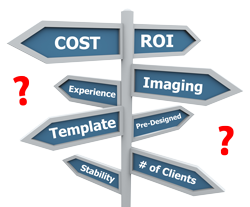Just select ours… : )
We know that you probably think that is the goal of this article. It is not. Unlike other articles on this site, the purpose of this article is NOT to persuade you to purchase our system… honestly. We would rather you select a system better suited for your practice… than be unhappy with ours. As a vendor of a working system, we see vendor changes to us and other working systems every day. Sometimes the issues may not justify the pain of a vendor change, but they missed out on the opportunity to select an EMR that streamlined their practice, and instead ended up with an EMR they can tolerate. This article will help you identify common EMR selection mistakes and give you practical advice on how to select an EMR system and get it right the first time.
Write down a pro/con list and give an overall rating after each demo
Don’t buy a system without comprehensive Ophthalmic Interfaces & Content
Don’t buy a system just because it looks simple and/or attractive
Hyper fixating on specific features can cause you to lose sight of the product’s overall value. If you drive demonstrations with feature Q & A, you are distracting yourself from seeing the actual product, and will likely not be able to discern the product’s overall value.
During your first demonstration, ask that they show you how a new patient visit is entered from check in to check out, then allow the demonstration to go uninterrupted. Don’t ask questions or guide the demonstration in any way. Look deeply into the product they are presenting. Don’t tell them what you are looking for and open your mind to things you may not be expecting. You may find that a product addressed something in a way that you could not have imagined. If you cannot see the overall value of their product in their uninterrupted demonstration, or they ignored your request to document a new patient visit (relying on carry forward features), the value is likely not there.
Keep a pro/con list and give an overall rating right after each demo.
Our sales department can accurately estimate the likelihood of you purchasing our system simply by asking you how many products you have evaluated in the past. Most practices will end up purchasing one of the last 3 products they evaluated. Why? Because after a while they lose track of who they liked, and they also forget how much better a system they saw early on was compared to one they’ve recently seen. After you’ve seen all the products you are going to consider, go back through all your notes and then get a 2nd demo of the top 3 products before making your final selection to refresh your memory.
Don’t believe the hype.
Most doctors, consultants, and online bloggers who freely dish out their experiences via testimonials, YouTube videos, and blogs are either paid marionettes or in some cases actors that aren’t users at all. Some of the worst EMR systems have very deep pockets as result of angel investors who read on Forbes that EMR is where to put their money. Investors can’t tell the difference between a good system and a bad one, they rely on a pitch (think Shark Tank). If they fall for it, they are all in and use their money to hire the best marketing firms in the country to create an “Image”. They will use any kind of propaganda they can to create an image that thoroughly convinces you that their system is more than what it really is. Don’t underestimate them… they are very good at it. Millions of investor dollars can buy an EMR company, an attractive website, clever YouTube videos, massive trade show booths, an army of clueless sales agents, and fictional testimonials, but it cannot make an EMR product a good product for your practice.
Learn how to interpret User Satisfaction Surveys.
Understand that a User Satisfaction Survey is a subjective and often biased survey. Sure, we are proud of our results, but the reality is that most doctors that are happy with their system don’t spend any time or energy answering online questions or promoting a product that they have no vested interest in. The ones that do are often polarized. They either are extremely happy, have a vested interest, or are extremely angry. A User Survey will certainly bring to light companies that are failing miserably, but of the working ones, the results should not be heavily relied upon, especially when the number of responses are low. AAO or ASCRS does NOT rank companies, and in fact intended the surveys to become a reference for you to consider and interpret on your own. The results can be interpreted in a variety of ways depending on how you look at them. Because of the nature of the survey, you should look at them as something that will help you in your decision process, not something that will make the decision for you.
Interested in our survey results? Click Here
Don’t buy a system without comprehensive Ophthalmic Interfaces & Content.
One of the things that make Ophthalmology unique is the amount of diagnostic equipment that is benefited by interfacing. Ophthalmic Interfaces are a good way to gauge the amount of time the system has invested in the specialty. If their interfaces are sub-par, you can bet with certainty their Ophthalmology content is too. And by the way, make sure their interface really is an interface. Most interfaces are model specific and require coordination with the diagnostic equipment vendor. Even though DICOM is a non-proprietary standard, displaying Ophthalmic Images properly for each vendor often requires coordination and testing with each vendor. The interfaces are not one size fits all and are not simple screen capture software. If they haven’t invested in the Ophthalmic specialty by now, products like ours who have invested in the specialty will push them out of the market
Don’t buy a system just because it looks simple and/or attractive.
A sign of a good system is how simple it looks, but simple can also mean featureless. When you first start on a system, you will appreciate simple, but after a few weeks, you will need comprehensive. Don’t sacrifice comprehensiveness for simplicity, but at the same time, comprehensive doesn’t have to be complicated. It is a balancing act, but a good system will have a good balance of simple and comprehensive.
Don’t buy ANY system without entering a New Patient Visit.
This is the biggest mistake practices make. Most users do not try the system out for themselves before they buy. They have no idea how much data entry will be required of them for the rest of the life of their practice. To be fair, keep in mind most systems will require a bit of training to use it effectively, but it should not require months of training just to get the basics in. If you skip this step, YOU WILL REGRET IT.
Don’t buy a system from a company that can’t say no.
We all like getting our ego massaged, but our ego can get us in trouble. A company that is willing to be honest with you before the sale, is a company that you will enjoy doing business with after it. When a deal is on the line, honesty in sales can be hard to come by but is the mark of a company whom people will trust in the long run. A reputable company has fair policies & procedures that are followed, and they will offer nothing but realistic expectations. They will draw the line if you start bargaining with them beyond what is sustainable to their business. If a company discounts their product 60% to get the deal, does not admit flaws, and does not provide realistic expectations, they are probably not doing too well, and you are probably being lied to.


 EyeMD EMR Named 2024 Best In KLAS: Ambulatory **Ophthalmology** EMR
EyeMD EMR Named 2024 Best In KLAS: Ambulatory **Ophthalmology** EMR